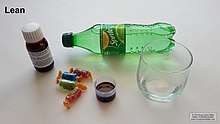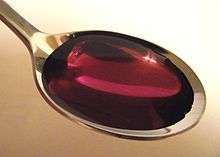Lean (drug)
Lean, also known as purple drank and several other names, is a recreational drug cocktail, prepared by combining prescription-grade cough syrup with a soft drink and hard candy. The concoction originated in Houston, Texas, and is popular among those who belong to the hip hop subculture or reside in the southern United States.[1]

Overview

Names
The term lean refers to "abusers' propensity of having difficulty in standing up straight."[2] "Purple drank" references its typically purple hue, as the cough syrups employed are often purple in color, and an African-American Vernacular English term for an alcoholic beverage or intoxicating drink. Other names include sizzurp,[3] syrup,[3] drank,[3] barre,[3] purple jelly,[3] wok,[4] Texas tea,[5] dirty Sprite,[6] and Tsikuni.[7]
Ingredients
Typically, the base for lean has been prescription cold medicine, specifically cough syrup, one that contains both promethazine and codeine, but over-the-counter cold medicine that lists dextromethorphan as the active ingredient has also been used, as it can produce similar effects and eliminate the need for a doctor's visit.[8][9] To create a drinkable mixture, the cough syrup is combined with Sprite, Mountain Dew, or grape-flavored Fanta and is typically served in a foam cup.[10][11][11] A hard candy, usually a Jolly Rancher, may be added to give the mixture a sweeter flavor.[1]
Effects
The physiological effects of lean on the user is to produce mild "euphoric side effects", which are accompanied by "motor-skill impairment, lethargy, drowsiness, and a dissociative feeling from all other parts of the body."[11] Houston author Lance Scott Walker noted that the super-sweet combination of soda, cough syrup, and Jolly Ranchers provides a flavor and mouthfeel, which stays on the tongue for an extended duration. This phenomenon is often appealing to first-time users.[12] Lean is often used in combination with alcohol and/or other drugs.[11]
Hazards
In an article following the hospitalization of the rapper Lil Wayne alleged to be related to lean, the Los Angeles Times spoke to physician and hospitalist Dr. George Fallieras on the hazards of the concoction. Fallieras stated that in its intended usage, "The codeine in the medicine serves as a pain reliever and also suppresses coughing. A second drug in the cough syrup, known as promethazine, is used as an antihistamine and commonly used to treat motion sickness and nausea. It is also a bit of a sedative—employed partly to keep people from drinking too much of the stuff. This is a very common cough syrup that, when taken in appropriately prescribed quantities, is quite safe."[13]
Dangers arise in higher doses since promethazine is a depressant of the central nervous system (CNS), and codeine is a respiratory depressant. When codeine is taken in very large amounts, it can cause one to stop breathing.[13] Using alcohol and other drugs alongside lean increases the chance of respiratory depression.[13] Fallieras stated that the concoction does not cause seizures itself, but increases their likelihood in those susceptible to them.[13] The drink includes a massive amount of the opiate codeine, which can be addictive in high doses, and Fallieras states that "promethazine has at least anecdotally been noted to intensify the euphoric effects of codeine in the brain."[13]
The addictive nature of the drink means that trying to discontinue regular usage can bring about symptoms of withdrawal.[13] In a 2008 interview with MTV News, Lil Wayne described the withdrawal as feeling "like death in your stomach when you stop. Everybody wants me to stop all this and all that. It ain't that easy."[14]
Lean is confirmed or suspected to have caused the deaths of several prominent users. Respiratory depression is a potentially serious or fatal adverse drug reaction associated with the use of codeine, but mainly the danger lies in the much more potent and CNS-depressing phenothiazine-related antihistamine promethazine. This depression is dose-related and is the mechanism for the potentially fatal consequences of overdose: respiratory or cardiac arrest. As with most CNS depressants, mixing with alcohol greatly increases the risk of respiratory failure and other complications.[15]
History
According to Houston-based author Lance Scott Walker, lean developed in that city around the 1960s when blues musicians would take Robitussin and cut it with beer. Later when wine coolers came onto the market, they substituted for beer.[12] These blues musicians lived in Houston's Fifth Ward, Third Ward, and South Park neighborhoods and the practice was taken up by the generation of rappers growing up in the same parts of the city.[12] In the 1980s and 1990s the formula changed to using codeine promethazine cough syrup, somewhat like the Glutethimide and codeine combination that was popular from the seventies up to the early nineties.[12]
Professor Ronald Peters, also a Houston resident, points out that lean remained a local Houston phenomenon until the 1990s rapper DJ Screw released several tunes mentioning the drink in his mixtapes, which were extremely popular in the Houston area.[12]
Walker holds that DJ Screw's music was particularly appropriate for Houston's climate. Due to the heat and expanse of the Houston area residents spent long drives in their cars, "the music that most appropriately complements that has always been the music of DJ Screw, it's slowed down—and when I say slowed down I mean he would record sessions in his apartment with rappers freestyling over beats and he would make these big mixtapes and then he would actually slow them down even further on his cassette recorder."[12] DJ Screw's invoking lean in his lyrics and his use of slow tempos had caused his style to be characterized "[a]s if the song itself has taken too much codeine promethazine".[12] Rappers outside of Houston soon adopted aspects of his style.[12]
Walker points out that lean had never been stigmatized in Houston, but with the apparently lean-related early death of DJ Screw, the concoction became the focus of law enforcement in the Houston area with felony charges being applied for some aspects surrounding it.[12]
Popularization

Houston producer DJ Screw popularized the concoction, which is widely attributed as a source of inspiration for the chopped-and-screwed style of hip hop music.[16][17] The promethazine and codeine concoction first gained popularity in the underground hip hop scene in Houston,[17] where musician Big Hawk said it was consumed as early as the 1960s and 1970s, becoming more widely used in the early 1990s.[18] Because of usage by rap artists in Houston, it became more popular in the 1990s.[19] Its use later spread to other southern states.[16] In June 2000, Three 6 Mafia's single "Sippin' on Some Syrup", featuring UGK, brought the term purple drank to a nationwide audience.[20]
In 2004, the University of Texas found that 8.3% of secondary school students in Texas had taken codeine syrup to get high.[16] The Drug Enforcement Administration reports busts involving syrup across the southern United States, particularly in Texas and Florida.[16] As of 2011, the price of lean in Houston is twice the price as it is in Los Angeles.[19]
In a 2019 interview, American rapper Future spoke about quitting lean and stated that he was afraid that his fans would believe his music has changed if he had publicly admitted to quitting earlier.[21] Future expressed disappointment after American rapper Juice Wrld told him that he was influenced by his music to try lean when he was young. Future stated "It’s like, ‘Oh shit.’ How many other sixth-graders did I influence to drink lean?"[21] The two artists had released a collaborative mixtape titled Wrld on Drugs in October 2018.[21] Lil Nas X's hit song "Old Town Road" includes the line "Lean all in my bladder", though Lil Nas X has stated he does not endorse the drug.[22]
Notable incidents of use
DJ Screw, who popularized the codeine-based drink, died of a codeine–promethazine-alcohol overdose on November 16, 2000, several months after the video of Three 6 Mafia's single debuted.[23]
Big Moe, a DJ Screw protégé whose albums City of Syrup and Purple World were based on the drink and who has been described as having "rapped obsessively about the drug",[24] died at age 33 on October 14, 2007, after suffering a heart attack one week earlier that left him in a coma.[25] There was speculation that lean may have contributed to his death.[26][27]
Pimp C, widely influential Port Arthur, Texas, rapper and a member of rap duo UGK, was found dead on December 4, 2007, at the Mondrian Hotel in West Hollywood, California. The Los Angeles County Coroner's Office reported that the rapper's death was "due to promethazine-codeine effects and other unestablished factors." Ed Winter, assistant chief of the Coroner's Office, said the levels of the medication were elevated, but not enough to deem the death an overdose. However, Pimp C had a history of sleep apnea, a condition that causes one to stop breathing for short periods during sleep. A spokesman for the coroner's office said that the combination of sleep apnea and cough medication probably suppressed Pimp C's breathing long enough to bring on his death.[28][24]
Fredo Santana, an American rapper who frequently made references to the drink in his music, died of a seizure on January 19, 2018. According to TMZ, he had been suffering from liver and kidney problems, which were believed to be the result of his addiction.[29]
In September 2006, Terrence Kiel, a San Diego Chargers player, was arrested during practice for the possession with intent to sell prescription cough syrup for use in making the drink.[16] Kiel was caught trying to ship a case of syrup to a friend via FedEx. Kiel was charged with two felony counts of transporting a controlled substance and three counts of possession for sale of a controlled substance.[30]
On July 8, 2008, Johnny Jolly, a Green Bay Packers player, was pulled over in his car by the police for playing an excessive level of music in a nightclub parking lot. The officers found a Dr Pepper bottle in a holder next to two Styrofoam cups containing soda and ice. The officers said the cups and the bottle all emitted "strong odors of codeine"[31] even though the codeine is odorless according to National Institutes of Health.[32] The case was dismissed,[33] but charges were refiled in December 2009 after the Houston Police Department acquired new equipment that allowed the police to test the evidence again. Jolly faced a possible maximum sentence of up to 20 years in jail, but as a first time offender he would be eligible for probation.[34]
On July 5, 2010, former Oakland Raiders quarterback JaMarcus Russell was arrested at his home in Mobile, Alabama, for possession of codeine syrup without a prescription. He was arrested as part of an undercover narcotics investigation. Russell was booked into city jail and released soon afterwards after making his bail.[35]
On March 15, 2013, Lil Wayne was hospitalized with seizures allegedly after taking the drug.[36] Fellow rapper Birdman, however denied that the seizures were in any way connected to drugs.[37]
On June 11, 2013, just days after being robbed at gunpoint in San Francisco, rapper 2 Chainz was arrested at Los Angeles International Airport on charges of possessing promethazine and codeine (the primary ingredients of lean) along with marijuana.[38]
Mac Miller, who died of a drug overdose not involving lean, spoke openly of his addiction to lean.[39]
Commercial products

Several legal commercial products loosely based on the concept of "purple drank" are marketed in the United States. In June 2008, Innovative Beverage Group, a Houston, Texas-based company, released a beverage called "Drank". The commercial product contains no codeine or promethazine, but claims to "Slow Your Roll" with a combination of herbal ingredients such as valerian root and rose hips as well as the hormone melatonin.[40][41] Similar "anti-energy" or relaxation drinks on the commercial market use the names "Purple Stuff", "Sippin Syrup", and "Lean".[42][43][44]
Criticism
These commercial products have been criticized for their potential to serve as gateways to the dangerous illegal concoction.[43][44][45] At a mental health conference in February 2010, Dr. Ronald Peters, Jr., of the University of Texas Health Science Center said of "Drank": "They're taking the name, and they're trying to market it to young people." He described the beverage as "the worst thing I've ever seen on the street since the making of candy cigarettes".[45]
References
- Tamara Palmer (2005). Country Fried Soul: Adventures in Dirty South Hip-hop. Outline Press Limited. p. 188.
- Richard Klemme, USE OF PROMETHAZINE WITH CODEINE SYRUP: COUGH/COLD EPIDEMIC OR SIGNIFICANT ABUSE? Archived May 16, 2008, at the Wayback Machine, Texas State Board of Pharmacy Newsletter, Volume XXV, Number 2, Spring 2001. The name "lean" refers to "abusers’ propensity of having difficulty in standing up straight."
- Bryan Robinson, Cough Syrup Abuse in Texas Takes Center Stage, ABC News, August 17, 2005
- https://drugabuse.com/dextromethorphan/lean-purple-drank/
- Shaheem Reid, Lil Wayne On Syrup: 'Everybody Wants Me To Stop ... It Ain't That Easy', MTV.com, February 28, 2008
- "Archived copy". Archived from the original on October 26, 2015. Retrieved October 19, 2015.CS1 maint: archived copy as title (link)
- "(U//LES) LulzSec Release: Arizona "Purple Drank" Warning". Publicintelligence.net. Retrieved January 21, 2018.
- "Dextromethorphan (Oral Route) Description and Brand Names - Mayo Clinic". www.mayoclinic.org. Retrieved August 19, 2019.
- Painter, Kim. "Sizzurp: What you need to know about cough syrup high". USA TODAY. Retrieved August 19, 2019.
- "T.I. Arrest -- Sippin' on Sizzurp?". TMZ. Retrieved August 19, 2019.
- Melissa Leon (March 17, 2013). "Lil Wayne Hospitalization: What the Hell Is Sizzurp?". The Daily Beast.
- Marah Eakin (March 26, 2013). "Learn all about the long, lean history of "sizzurp" with this 7-minute audio primer". A.V. Club.
- Amina Khan (March 18, 2013). "Doctor explains sizzurp's powerful high -- and deadly side effects".
- Allison Samuels (March 18, 2013). "Rapper Lil Wayne and His Struggle With Sizzurp 'Drank'". The Daily Beast.
- "Alcohol Interactions with Other Drugs". Alcohol and Other Drugs Program Public Health Division, Health Department of Western Australia. 1999. Archived from the original on January 18, 2016. Retrieved June 4, 2013.
- Leinwand, Donna (October 18, 2006). "DEA warns of soft drink-cough syrup mix". USA Today. Retrieved October 23, 2006.
- Corcoran, Michael Joseph (2005). "The Geto Boys and DJ Screw: Where the Dirty South Began". All Over the Map: True Heroes of Texas Music (1st ed.). Austin: University of Texas Press. pp. 23–26. ISBN 978-0-292-70976-8.
- Joseph Patel, Chopped & Screwed: A History, page 2, MTV.com. Accessed January 7, 2010.
- Schiller, Dane. "Purple Drank scheme allegedly made millions for smuggling ring." Houston Chronicle. Wednesday October 19, 2011. Retrieved on October 23, 2011.
- Walker, Yolanda (October 20, 2006). "Drug-laced cough syrup tempts Texas teens". WFAA. Archived from the original on January 25, 2007. Retrieved October 28, 2006.
- Charles Holmes (January 17, 2019). "Future Changed Rap for a Generation. He Doesn't Know How to Feel About It". Rolling Stone. Archived from the original on May 24, 2019. Retrieved January 28, 2020.
- Haleigh Mauro (January 24, 2020). "The Real Meaning of the "Old Town Road" Lyrics". Cosmopolitan. Retrieved January 28, 2020.
- Demby, Eric (January 11, 2001). "Codeine Overdose Killed DJ Screw, Medical Examiner Says". MTV.com. Retrieved October 28, 2006.
- Kristie Rieken, Cough syrup found in Pimp C's hotel had no label, Associated Press, February 5, 2008
- DJs – Rapper Big Moe Dies, contactmusic.com, October 15, 2007
- Leslie Casimir, Rapper's death leads teens to re-evaluate lifestyle; Fans and friends wonder whether drug was a factor in his heart attack, Houston Chronicle, October 20, 2007
- Houston rappers remember Big Moe, by Eyder Peralta, Houston Chronicle, October 16, 2007
- "Cough syrup cited in rapper Pimp C's death". LATimes.com. February 5, 2008. Retrieved March 15, 2008.
- "Rapper Fredo Santana Dead from Fatal Seizure". TMZ.com. January 20, 2018. Retrieved January 20, 2018.
- Chargers safety Kiel arrested on drug charges, USA Today, September 28, 2006
- Jolly faces unclear future – Trial on felony charge of drug possession awaits Packers defensive lineman, Milwaukee Journal Sentinel, July 11, 2009.
- "Codeine, Compound CID 5284371". National Institutes of Health. Retrieved January 19, 2019.
- Case against Jolly dismissed, "Milwaukee Journal Sentinel", July 16, 2009
- "540 ESPN Milwaukee". Espnmilwaukee.com. Retrieved January 4, 2010.
- 2010-07-05 Archived July 8, 2010, at the Wayback Machine
- "Lil Wayne Hospitalized - In Critical Condition After More Seizures". TMZ.com. March 15, 2013. Retrieved April 10, 2014.
- Billboard Staff (March 18, 2013). "Lil Wayne's Seizure Had 'Nothing to Do With Drugs,' Says Birdman". billboard. Retrieved February 22, 2017.
- "2013-11-06". News.radio.com. June 11, 2013. Retrieved April 10, 2014.
- Streit, Kate (September 14, 2018). "Here's What You Need To Know About Lean—The Cough Syrup Drink That Mac Miller Spoke About Before His Death". Simplemost. Retrieved July 30, 2019.
- "'Slow Your Roll' With DRANK From Innovative Beverage Group – the World's First Extreme Lifestyle Relaxation Beverage". Yahoo. June 10, 2008. Archived from the original on December 2, 2008. Retrieved September 16, 2008.
- Adventures in Press Releases: The Anti-Energy Drink Archived April 4, 2009, at the Wayback Machine By Sarah DiGregorio in Edible News, June 4, 2008
- 'Sippin Syrup' being sold in stores creates controversy, theGrio website, September 25, 2009. Retrieved November 27, 2009.
- Jemimah Noonoo, Anti-Energy Drink Fuels Concerns Over Marketing Archived July 6, 2010, at the Wayback Machine, Houston Chronicle, November 28, 2008; retrieved from commercialalert.org website on November 27, 2009
- Boyce Watkins, Company Makes Money from Deadly Urban Trend: "Sipping Syrup", AOL Black Voices, September 29, 2009
- Kim Horner, Anti-energy drink hard for some mental health experts to swallow, Dallas Morning News, February 18, 2010